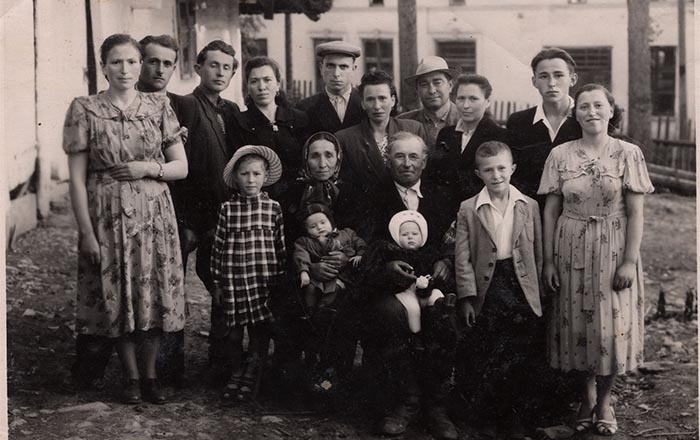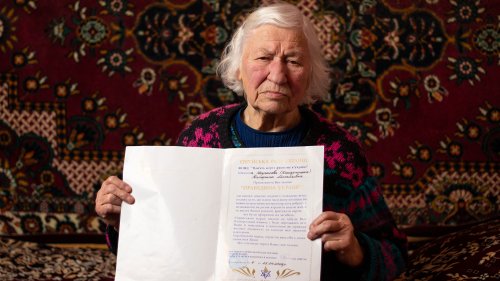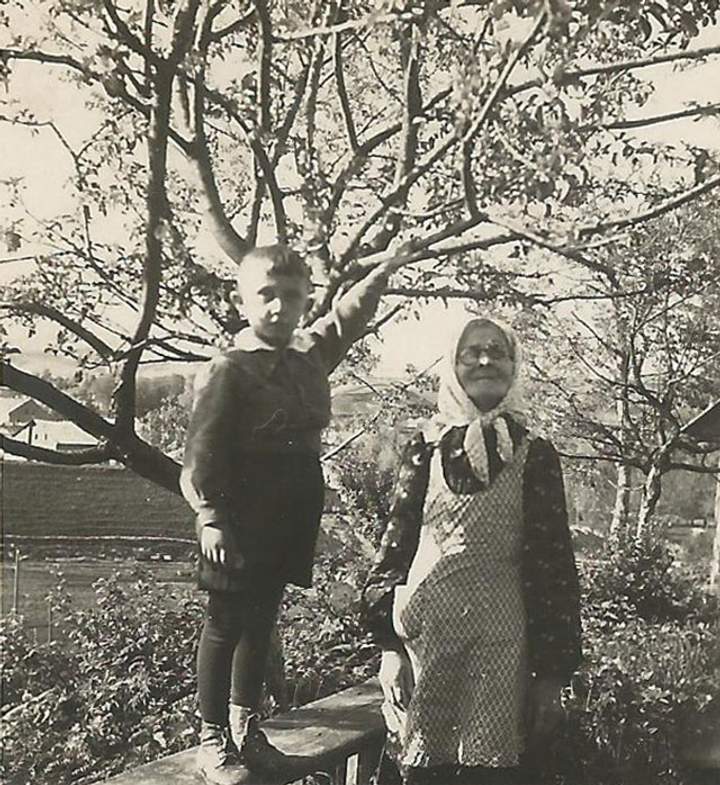“I am not afraid of death”

A rescue during the Holocaust
Since 2012, the European Day of the Righteous has been celebrated on 6 March. For more than half a century, the special commission of Yad Vashem, the World Holocaust Remembrance Center in Jerusalem, has been awarding the title of Righteous Among the Nations to gentiles who risked their lives to rescue Jews during the Holocaust. Today nearly twenty-eight thousand people from Poland, the Netherlands, France, Ukraine, Belgium, Latvia, and Hungary have been awarded this title. This year the Verkhovna Rada declared 14 May as the day on which we honor the Ukrainians who rescued Jews during the Second World War. One of the initiators commented on this decision on social media: “Russia is seeking to exploit the memory of the Holocaust in order to discredit the Ukrainian liberation movement by disseminating fakes about the mass participation of Ukrainians in the destruction of Jews. Therefore, we must remind ourselves and others about those who saved the lives of Holocaust victims.”
On the one hand, honoring those who rescued their Jewish neighbors is an integral component of the contemporary culture of remembering the Holocaust all over the world, all the more so as the last of these people are still living among us. In the last few years, Margarita Yakovleva has been working on the project Word of the Righteous. She searches for the Righteous and their descendants, documents memoirs, and creates documentaries based on them. She announced that as of spring 2020, no more than thirty Righteous were living in Ukraine. Today there are even fewer. In any case, drawing the authorities’ attention to them would not be superfluous.
On the other hand, discussions of the Holocaust in Ukraine cannot be limited solely to the rescue topic. Nor is it as unambiguous as it seems at first glance. Attempts to instrumentalize this topic can lead to harmful consequences. This is perfectly illustrated by recent events in Poland, where the well-known historians Barbara Engelking and Jan Grabowski were tried in civil court. For allegedly slandering the late Edward Malinowski, they were obliged to make a public apology to his niece. During the Nazi occupation, he was the village head. After the war, he was arrested on charges of participating in the murder of eighteen Jews who were hiding near the village. A Jewish woman who survived the Holocaust came to his defense, stating that Malinowski, who knew about her real ethnic origins, helped her go to Germany as a forced laborer, and that is how she was able to be saved. He was acquitted. However, Engelking discovered and publicized subsequent statements made by this Jewish woman. According to her, in return for Malinowski’s help, she handed over her property to him, as well as the cash that she had on her. She also admitted that she knew about his dishonorable conduct toward other Jews. The survivor’s sons confirmed that they had heard her saying that Malinowski was a “bad person.” Clearly, this discovery offended his niece and especially the defenders of the “Polish hero’s good name” from the right-wing political spectrum, who launched the lawsuit.
It is true that some rescuers profited from the property of those whom they were helping, as in Malinowski’s case—and to exploit them or even sexually abuse them. Helping some Jews does not mean that they may not have persecuted others. During the Holocaust, the line between rescue and betrayal was very fine. Hence, the procedure for awarding the title of Righteous Among the Nations is lengthy and complex. One of the mandatory points is that rescuers did not derive material or any other kind of benefits from rescuing someone.

Despite these strict rules, according to Katya Gusarova, who works in the Department of Righteous Among the Nations, between 350 and 400 people are awarded this title every year. Approximately seven percent of applications are rejected for various reasons. The most famous, but not the only, case of a candidate's being rejected concerns Metropolitan Andrei Sheptytsky. According to received opinion, he was involved in rescuing at least 150 Jews, some of whose names have been identified by researchers. In 2008 the Jewish Council of Ukraine recognized him as a Righteous of Ukraine. At the very least, half of those who, like Sheptytsky, have been awarded this alternative title, have not been recognized by Yad Vashem. Unlike him, their stories rarely draw the attention of researchers, and they are not mentioned in the public space.
Among them is the Komarnytsky family from Turka. In 2006 nine members of this family were granted the title of Righteous of Ukraine.
In January 2021, a team from the “Voicelessness” documentary project met with 84-year-old Kateryna. It is hard for her to recall the events of the Second World War, but below is a transcription of the short interview with her:
What were your parents’ names?
Komarnytsky, Mykhail Ivanovych, Komarnytska, Anna Ivanivna.
How many brothers and sisters did you have?
Two brothers and five sisters; I was the sixth.
Can you tell us their names?
I can: Halia, Kosta, Slavka, Liuba, Darka, and I; and my two brothers, Mykhasko and Ivanko.
What did your parents do?
They had a farm: cows, piglets, chickens, and ducks. They had a big field. They grew potatoes. There was a garden. There was an orchard next to the house.
Where did you live?
The house consisted of the entrance, kitchen, and a very large room. We lived in that room.
Whom did your family shelter?
My mother knew that woman. I have forgotten her name. She was a midwife.
And your mother had eight children?
…a midwife.
Ivan is Kateryna’s brother, who is three years younger than her. He lives in Kharkiv oblast. We telephone him, and he supplements his sister’s account.
Kateryna: She came during the night. In a nightgown.
Ivan: And she says to Mama: “I’m not afraid of death, but I would like to die the way people die.”
Ivan and Kateryna, the youngest children, were generally not told who the woman was who turned up at their house. They might blurt something out and unwittingly bring danger upon them. Today they are among the last eyewitnesses of those events. Of the eight children of the Komarnytsky couple, three are still living. Besides Ivan and Kateryna, there is an older brother, Mykhailo.
Ivan: In the morning, my mother just said after the “Our Father”: “That old woman is our grandmother. She has come from the countryside. The Germans are shooting old people. Don’t even think about saying anything about this.” She said this constantly. Everyone else knew that she was Jewish, but my sister and I did not.
Kateryna: She was our grandmother! If anyone asked, [we said that] she was our grandmother from Melnychne, our mother’s mother.
Silence is not the only prerequisite of a successful rescue. The Komarnytskys set up a whole network of hideouts on their property. They were hidden from prying eyes. During the Holocaust, it was necessary to beware even of those who earlier could be considered desirable guests.
Kateryna: She slept on the oven ledge with us or hid in the cellar.
Ivan: This is the way it was in our house. In the winter, we hid granny away whenever someone came into the house. We, kids, hid at the back of the oven with our shoulders.
The danger was real. The occupying regime threatened with death anyone who offered even temporary shelter in their homes to Jews, supplied them with food, or helped them in some other way. Punishment awaited even those who knew but did not report facts of concealment. This was the subject of relevant announcements. The executions were a warning to frighten others. Rescuers knew perfectly well the risk to which they were exposing themselves and their loved ones.
Ivan: In Serednia Turka, some people who had hidden [Jews] were caught. So, everyone was taken to a ravine. They gave them shovels: dig. People were brought there to see how everything would take place there. They dug a pit. They were shot.
For a family with many children, hiding someone signified not just a mortal threat but also a constant material burden. It seemed that the Germans’ retreat would finally mean a return to the normal rhythm of life, for which everyone was waiting. But even afterwards, many rescuers suffered because of the suspicious attitude on the part of the Soviet authorities and often — their neighbors.
Kateryna: We suffered and hid until that war ended. Somehow with God’s help, everyone came out alive and well. Her son arrived, her daughter-in-law. They honored us; they visited us all the time.
They maintained relations with your family?
Very much so! Whenever there was a holiday, my mother would bring them something, and that Jewish woman would bring us something.
Ivan: When Turka was liberated, the Russians did not like, so to speak, the people who had hidden Jews. Because every government likes people who fear it. The idea was that if they had not been afraid of the Germans, then they’re not afraid of us.
What were the motives of rescuers? Frequently, neither they themselves nor the rescued can answer this question. Researchers say that good, like evil, is banal; thus, it is difficult to create a generalized portrait of a rescuer. It could be a person of any age, gender, ethnic or social origin, and political or religious preferences. It could be a criminal and even an antisemite. Most often, the concept of humaneness is mentioned; the realization that standing before you is not the bogeyman from propaganda posters but a human being who needs help.
Kateryna: We got along very well with the Jews, and the Jews with us.
Ivan: My father taught me this: “Ivan, if you can do good for a person, do so; don’t even think of doing something bad because it will pass on to your children, grandchildren, and great-grandchildren.”
Like his older sister, Ivan cannot remember the name of the rescued woman. But he offers up an important fact: She was the mother of Lemel Brandelstein.
We hear about him and his wife, Bronia, from practically everyone with whom we communicate in Turka. At the beginning of the war, they were evacuated to the Soviet rear. Their daughter, Sania, was born there. They returned to Turka in 1945. They were among the few Jews who lived there after the war. Lemel was the school principal, he taught mathematics, and Bronia taught Russian language and literature. That is why everyone from the postwar generation of pupils remembers them. In Turka, the Brandelstein couple had a son named Kubus. After some time, they moved to Poland and from there—to Israel.

Today Jacob lives in Kfar Vradim, near Haifa. He is seventy-five years old. In his retirement, he is actively researching his family history and thus gladly agrees to speak with us online.
The rescued woman is indeed his grandmother:
Her name is Chava Brandelstein. Her maiden name was Mayer. She was born in Turka in 1876. She was a midwife. What is interesting is that her mother was a midwife, too. In 1897 my grandmother completed her studies in Lviv and worked in a hospital in Turka for many years. She was a well-known midwife.
My parents left Turka a few days before the war broke out. It took them six weeks to reach Bashkiria by train. They lived in Askino. My grandmother and grandfather remained in Turka. In 1942 my grandfather was killed. The Komarnytsky family hid my grandmother. For two years, she hid in the cellar.
Chava was sixty-six years old. Her rescue is untypical because elderly people had much fewer chances to survive the Holocaust. The occupying regime considered them unfit for work, and therefore they were the first to be killed. Moreover, rescuers took pity on them less frequently, thinking that they were adults and could take care of themselves.
From Jacob, we also learn of her subsequent fate:
In 1957 we left by train from Turka to Poland. In August, we arrived in Wałbrzych, and my grandmother died two months later. She was buried in the local cemetery. I have a photograph of her grave. In 1961 we left for Israel.
After arriving in Israel, Jacob’s father raised the question of recognizing the Komarnytsky family as Righteous Among the Nations:
I know that my father wrote to Yad Vashem. However, at the time, applications were being accepted only from people who had been directly rescued. But my grandmother died…
Over time, the regulations became more flexible, and applications began to be accepted from surviving descendants as well. Jacob found out about this in 2020, when he attended Gusarova’s lecture. He wrote the proper declaration about his grandmother’s rescue.
Gusarova predicts that the Komarnytsky case will probably be examined by Yad Vashem closer to the end of 2021. It is one of fifteen cases connected with Ukraine awaiting assessment.
Andriy Usach
Historian, doctoral student at the Ukrainian Catholic University, and head of the civic organization Pislia tyshi (After the Silence). His research specialty is the Holocaust in Ukraine, especially the question of local collaboration. He also works in the field of oral history. This lens allows us to examine the memory of violence more closely and animate it for a deeper understanding of the motives and experiences of the various actors in those merciless wartime events.
This article was published as part of a project supported by the Canadian non-profit charitable organization Ukrainian Jewish Encounter.
Originally appeared in Ukrainian @Zaxid.net
Translated from the Ukrainian by Marta D. Olynyk.
Edited by Peter Bejger.
NOTE: UJE does not necessarily endorse opinions expressed in articles and other materials published on its website and social media pages. Such materials are posted to promote discussion related to Ukrainian-Jewish interactions and relations. The website and social media pages will be places of information that reflect varied viewpoints.



















